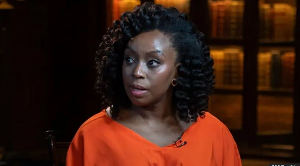Special to the Chicago Tribune
ELMINA, Ghana -- Inside the sunlit courtyard of a sprawling 15th Century castle off the coast of Ghana, a handful of men and women are gathered in a circle, holding hands and preparing to pray.
The waves of the Atlantic Ocean crash and rumble nearby, but one can almost hear a pin drop in the solemn hush that has fallen over this assembly of bronze, beige and ebony faces.
A regal woman wearing colorful robes begins to speak. "For our ancestors," says Dr. Patricia Newton, a physician and president of Sebayit Tours, the travel agency leading our small group of mostly Marylanders. "For their strength," she continues, "and what they endured, we give thanks."
Newton then passes around a bottle of water for each person to pour "libations" on the ground while sharing their thoughts.
The ritual is meant to pay homage to the millions of Africans whose harrowing odyssey into slavery can be traced to these West African shores.
One woman starts to cry. Others wear pained expressions that speak volumes about this place, where the past still resonates as loudly as the beat of an African drum.
We are at the infamous Castle of St. George d'Elmina, the oldest of the so-called slave castles dotting the jagged coastline of this nation of 18 million people.
During the slave trade that emerged here in the late 1400s, these one-time trading posts and military forts became holding places for captured Africans who were later put on slave ships bound for Europe and the Americas.
Today, more than 25 of the forts remain. Elmina and Cape Coast Castle, a few miles away, have been designated World Heritage Sites by the U.N.
This might not seem a particularly upbeat destination, but travelers from all over the world--particularly African-Americans--are making excursions to Ghana and other parts of Africa to view such sites.
Much in the way that Jews visit Israel or Catholics journey to Rome, African-Americans are making cultural pilgrimages here to explore their heritage and their roots.
"The classic comment is, 'I just want to see the motherland before I die,' " says Newton, who this year has organized expeditions to Ghana, Egypt, Ethiopia and South Africa. "I had one man tell me that he didn't care which country in Africa," she adds. "He just wanted to step foot on African soil."
Henderson Travel and Tours in Silver Spring, Md.--reportedly the oldest black travel agency in the country--first journeyed to Ghana in 1957 for the nation's inaugural independence celebration. Today, the company books about 100 trips annually all over the continent.
"Once, we had to go out and market Africa," says owner Gaynelle Henderson-Bailey. "Now it's had a ripple effect. We find once we send anyone, they tell family and friends."
But Henderson-Bailey acknowledges that "many Americans are ignorant about Africa." What they typically get on television is "famine, coups, disease and starvation," she says. "People are amazed to see big capital cities and wonderful sights that are traditional, cultural and historical."
Slightly smaller in size than Oregon, Ghana is a diverse country with coastal areas, grassy plains, low bush and savanna, as well as a tropical rain forest. The most densely populated areas are near the coast in the south, Kumasi in the Ashanti region to the west, and the capital city of Accra.
Although the U.S. State Department issued a travel warning to Americans this summer because of ethnic clashes in the far north, Ghana enjoys a democratic government and mostly stable politics.
Elmina Castle, built in 1482, is known as the oldest surviving European edifice in the tropics. Columbus reportedly stopped here before he sailed for the New World.
The whitewashed citadel sits on a cliff above the port town of Elmina, which derives its name from the Portuguese word mina, or gold mine.
When explorers arrived in the late 15th Century, they found gold--hence this former British colony was dubbed the Gold Coast.
Initially, the castle was where gold, ivory, spices and other goods were traded among the locals. That all changed when the export of human cargo became more profitable.
Elmina Castle, with its picturesque backdrop of palm trees and white-sand beaches bordered by the shimmering Atlantic, became a place of horrors.
The dungeons are dark and disquieting. Iron shackles line the walls. A skull and crossbones marks a holding cell where the defiant were left to starve to death.
"What these walls have seen," says castle guide Felix Nguah, while pointing out trapdoors and rope ladders used to take African women to the captain's private chambers.
There is the hypocrisy of a church near a slave auction block, but perhaps most gripping is the "door of no return," the last stop for captives before they were stripped and branded, then marched to waiting slave ships.
Those wishing to vicariously relive the experience can walk through the same stunted metal gates.
"Imagine saying goodbye to all that you have known--your family, your children," says Nguah. "The screams were said to be so loud they drowned the noise of many drums."
Today, a bustling community exists outside the castle perimeter. Fishermen in brightly painted canoes, or pirogues, haul in fresh tilapia, swordfish, snapper and shrimp. Bare-bottomed little boys swim, and women stroll while expertly balancing trays of assorted wares on their heads.
An approaching tour bus causes frenzied waving, shouts and greetings. Children offer tourists seashells--personalized if you give your name--for a bit of spare change.
But inside Elmina and Cape Coast Castles, says Chicago native David Smylie, "it's a lot to take in." Smylie's wife gave him a trip to Ghana, Senegal and Gambia as a 40th birthday present.
"It has been interesting," he says, "more of a learning experience than just enjoyable."
At Elmina, a small bronze plaque offers these words:
In Everlasting Memory of the anguish of our ancestors. May those who died rest in peace. May those who return find their roots. May humanity never again perpetrate such injustice against humanity. We the living vow to uphold this.
While the slave castles should be seen, Ghana's true flavor is captured in its cities and villages.
The character of the country and its people blends ancient African and colonial traditions with modern sensibilities, not to mention increasing Western influence.
Perhaps nowhere is the mix more apparent than in Accra, the capital and largest city with some 1.5 million people.
You have to marvel at a place where people chat freely on cell phones as chickens and goats saunter by.
Locals wear kente, a traditional cloth, as well as T-shirts and denim jeans. You can enjoy a slice of pizza and a Fanta soft drink (a favorite here) or akrantie, better known as palm nut soup.
Traffic in Accra is frenetic, with cars, bicycles, taxis and jitney-style buses jamming the streets, which are awash in color. In every direction there are stands weighed down with woven textiles in shades of bright orange, brilliant blues and gold.
Fruit stalls display bananas, pineapples, mangoes and dimpled pale green oranges that look odd but taste sweet.
Cocoa-colored young men hawk everything from magazines and bottled water--advised for tourists--to batteries.
Roadsides are cluttered with pottery, velour furniture and tiny shops with names that speak to the country's religious fervor: Great Is Jehovah Electrical and Great God of Wonders Fashion.
English is the official language, but with 75 different ethnic groups you will also hear Ga, Dagomba, Akan and Ewe, to name a few. Thus, we learn new words like akwaaba (ah-kwa-ba), which means welcome, medaase (me-das-say) or thank you, and obroni (o-broon-ee), for foreigner.
The latter term is not used much--many Ghanaians proudly express their kinship with African-Americans. "Hello, my sista" is often heard.
The historic Osu neighborhood in Accra is hip and edgy. We visited the African Market for sandals and jewelry; nightclubs like Indigo, which has a fun crowd and good music; and restaurants like Sole Mio, where a lobster meal costs about $7.
The Labone neighborhood looks like a typical middle-class American suburb, complete with candy-colored houses, well-tended lawns and gardens. Asylum Down is more earthy (it's one of many places to get your hair braided). In Ghana, large, grand homes exist near shanties without indoor plumbing or electricity.
For the visitor, lodging runs the gamut from tiny inns and midsize European chains to four-star hotels. Those who desire upscale accommodations can check into the posh La Palm Royal Beach Hotel, which overlooks the ocean. It boasts chic boutiques, several restaurants for fine dining and a beauty salon.
Among Accra's many attractions is Independence Square (often called Black Star Square), a parade ground erected in the 1960s when Queen Elizabeth II visited.
Nearby is the mausoleum of national hero Kwame Nkrumah, a leader in Ghana's independence movement and the nation's first president.
Art enthusiasts can visit the National Museum, founded in 1957. The objects on display provide insight into Ghana's rich history and culture. Sculpture, drums, photographs, swords and masks reveal many facts.
Clan staffs, for instance, identify members of a particular family unit. Oft-seen ivory and brass bracelets worn by men and women are ornamental but can also denote one's status in society.
The museum gift shop carries books, clothing, carvings and baskets, but shoppers may want to hold out for the Center for National Culture, known as the Arts Center.
This is Ghana's largest craft market. Rows of stalls offer everything from beads and brass work to leather goods and kente cloth. Noisy and dusty, it can be hectic, but it's fun bargaining with vendors who are tough negotiators.
We pick up T-shirts, ebony candlestick holders and statuettes. The currency in Ghana is the cedi, but nearly everyone accepts American dollars.
For a more authentic Ghanaian shopping experience, try Makola Market, the largest open-air emporium in Accra. Long blocks are crammed with people, food, animals, shoes, clothing and more.
More intellectual pursuits can be had at the W.E.B. DuBois Memorial Center for Pan African Culture. The African-American scholar and activist spent his final years in this modest home.
The staff is extremely knowledgeable. We see the office/library that still houses DuBois' book collection, a bronze bust of him, academic regalia from places like Harvard and, finally, his outdoor tomb.
The center also serves as a facility for research, public lectures, workshops, exhibitions and outreach programs. The African American Association of Ghana also meets here. A highlight of the trip is meeting the large community of expatriates, U.S. Embassy staff and others who welcome us.
Kumasi, another major city, is capital of the vast Ashanti region. The city hums with activity. Huge billboards advertise hair straighteners, Guinness beer and Pepsi, while others warn about AIDS.
Radio stations blast buoyant African "highlife" music, characterized by its rhythmic, percussive sound. The center of town has one of the largest open-air markets in West Africa.
The market is exhilarating, but we can't linger. We have an appointment with a traditional healer/priest known as Nana Abass. His Black and White Powers shrine sits on a hill on the outskirts of town, in the Meduma region.
Christianity is widely practiced in Ghana, but traditionalists still have a respected place in the culture. Nana--the name is a title of respect--is young but well-versed in ancient spirit rituals. Hundreds come here seeking his counsel for afflictions ranging from infertility to financial difficulties.
A meeting with Nana is like a cross between a psychic reading and entering a priest's confessional. After consulting with spirit forces, his remedies for several in our group included soaps, fragrant oils and prayer cloths.
The cities have many ethnic restaurants--French, Spanish, Chinese and Middle Eastern--but we want Ghanaian fare, so we seek out Jofel Restaurant in Kumasi's Nhyiaeso neighborhood.
Our buffet includes "red red" and beans (plantains and black-eyed peas), jollof rice, diced chicken with cashews, crisp fish in chili sauce and kontomire (a spicy dish made with spinach greens, palm oil and ground seeds of the agushi melon). There's plenty of orange and grape Fanta to wash it all down.
The food is surprisingly familiar, not unlike soul food or Southern cooking, and the tab is about $10, including tip.
Bumping along the countryside in a rented bus, we see miles of greenery, tropical flowers and red-clay soil on our way to small crafts villages outside Kumasi.
We identify more than a dozen different trees: cedar, ebony, mahogany, palm, coconut and bamboo. There are fruit trees like plantain, banana, mango and papaya. And never have we seen sese, acacia and nim trees.
Our first stop in the country is Bonwire, the traditional center of kente weaving, which originated with the Ashanti people.
A workshop is filled with fabric, thread and young men deftly producing the brightly woven cloth on large looms.
Daniel Abraa says he began weaving at age 13--some 10 years ago. He hands me a baby blue pattern shot with silver thread, which is hard to resist buying.
Further down the road we reach Ntonso, the village best known for adinkra cloth. The word "nkra" means message or goodbye. Adinkra cloth is printed with symbols that represent proverbs and tell a story. It is also a funeral cloth.
The women mix thick black dye, while nearby the men use carved calabash stamps to create the cloth's exquisite designs.
At the village of Ahwiaa, famous for wood carving, there are masks, drums and African stools, which we learn have spiritual significance.
A visit to the villages affords an opportunity to see Ghanaians who still live much like their forebears. We spy women carrying jugs of fresh water. A funeral procession that will go on for three days is attended by mourners clad in black and red. Babies swaddled in batik cloth are carried as they have been for centuries, on their mothers' backs.
We even attend a traditional wedding at a chief's palace where turquoise peacocks strut freely on the grounds and there is much drumming and dancing.
Later, we stop in the town of Nsawam, famed for its freshly baked loaves of sweet, chewy bread.
As the day winds down, our guides--Kofi Amos and driver Isaac Gyasi--regale us with fables about Anansi the spider, a wise creature and symbol of wisdom here.
Many in our group have come away from their visit to Ghana with newfound wisdom.
"I wanted to come to Africa so that I could learn more about the race, the culture, the people, the heritage," says Miriam Barrett, a visual artist and photographer from Baltimore. "It has been very touching, especially seeing the slave castles from the perspective of knowing what the ancestors went through. I won't preach," she says, "but I will try to pass it on to other people."














